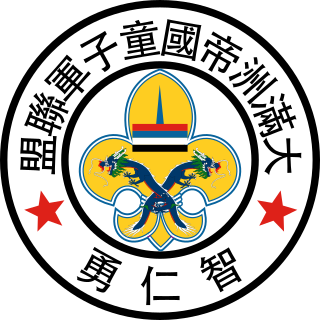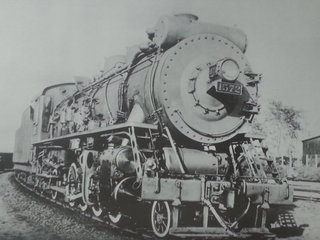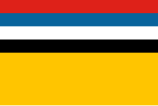
Manchukuo was a puppet state of the Empire of Japan in Northeast China that existed from 1932 until its dissolution in 1945. It was ostensibly founded as a republic, its territory consisting of the lands seized in the Japanese invasion of Manchuria; it was later declared to be a constitutional monarchy in 1934, though very little changed in the actual functioning of government. Manchukuo received limited diplomatic recognition, mostly from states aligned with the Axis powers, with its existence widely seen as illegitimate.

The national flag of Japan is a rectangular white banner with a crimson-red circle at its center. The flag is officially called the Nisshōki but is more commonly known in Japan as the Hinomaru. It embodies the country's sobriquet: the Land of the Rising Sun.

The national flag of the Democratic People's Republic of Korea, commonly known as North Korea, consists of a wide horizontal red stripe bordered above and below by a thin white stripe and a broad blue stripe. The red stripe is charged near the hoist with a five-pointed red star inside a white disc. The design of the flag is defined in the North Korean constitution and regulations regarding the use and manufacture of the flag are outlined in the country's national flag law. The North Korean government credits Kim Il Sung, the country's founder and first leader, as the designer of the flag. The flag was officially adopted on 8 September 1948, with the passing of North Korea's first constitution by the Supreme People's Assembly. The North Korean flag is banned in South Korea by the National Security Act.

Changchun is the capital and largest city of Jilin Province in China. Lying in the center of the Songliao Plain, Changchun is administered as a sub-provincial city, comprising 7 districts, 1 county and 3 county-level cities. According to the 2020 census of China, Changchun had a total population of 9,066,906 under its jurisdiction. The city's metro area, comprising 5 districts and 1 development area, had a population of 5,019,477 in 2020, as the Shuangyang and Jiutai districts are not urbanized yet. It is one of the biggest cities in Northeast China, along with Shenyang, Dalian and Harbin.

The National Emblem of the People's Republic of China is a national symbol of the People's Republic of China and contains in a red circle a representation of Tiananmen Gate, the entrance gate to the Forbidden City imperial palace complex, where Mao Zedong declared the foundation of the People's Republic of China (PRC) in 1949. Above this representation are the five stars found on the national flag. The largest star represents the Chinese Communist Party (CCP), while the four smaller stars represent the four revolutionary social classes as defined in Maoism. The emblem is described as being "composed of patterns of the national flag":
...The red color of the flag symbolizes revolution and the yellow color of the stars the golden brilliant rays radiating from the vast red land. The design of four smaller stars surrounding a bigger one signifies the unity of the Chinese people under the leadership of the Communist Party of China (CPC).
—China Yearbook 2004
The National anthem of Manchukuo was one of the many national symbols of independence and sovereignty created to foster a sense of legitimacy for Manchukuo in both an effort to secure international diplomatic recognition and to foster a sense of nationalism among its inhabitants.
The flag and the coat of arms of Johor are state symbols of Johor, Malaysia. Like other states of Malaysia with Malay royalties, the state symbols of Johor are influenced by Johor's royalties, as well as Islam and the political and natural features of the state.

The national flag of the People's Republic of China, also known as the Five-star Red Flag, is a Chinese red field with five golden stars charged at the canton. The design features one large star, with four smaller stars in an arc set off towards the fly. It has been the national flag of China since the foundation of the People's Republic of China on 1 October 1949. The flag was designed by Zeng Liansong.

The flag of the Qing dynasty was an emblem adopted in the late 19th century (1889) featuring the Azure Dragon on a plain yellow field with the red flaming pearl in the upper left corner. It became the first national flag of China and is usually referred to as the "Yellow Dragon Flag".

Manchurian nationalism or Manchu nationalism refers to the ethnic nationalism of the Manchu people or the territorial nationalism of the inhabitants of Manchuria, regardless of ethnic origin.

Edward Tyrer was a senior British colonial police officer who was Commissioner of Police, Hong Kong, from December 1966 to July 1967.

Kenkoku Daigaku or simply Kendai wasis an educational institution which was short-lived in Hsinking, the capital of Manchukuo, the Japanese puppet state in occupied Manchuria during the Second Sino-Japanese War. It operated from May 1938 to August 7, 1945.

The Gegenmiao massacre or the Gegenmiao incident was a war crime by the Red Army and a part of the local Chinese population against over half of a group of 1,800 Japanese women and children who had taken refuge in the lamasery Gegenmiao/Koken-miao (葛根廟) on August 14, 1945, during the Khingan–Mukden Operation in Soviet invasion of Manchuria.
The East Asian Games, also known as the Asian Development Games were multi-sport events organized by the Japan Association of Athletics Federations (JAAA). The games were meant to be a replacement to the cancelled 1938 Far Eastern Championship Games and 1940 Summer Olympics originally to be hosted by Japan, and also served as a propaganda tool for Japan.

The Soviet invasion of South Sakhalin, also known as the Battle of Sakhalin, was the Soviet invasion of the Japanese portion of Sakhalin Island known as Karafuto Prefecture. The invasion was part of the Soviet–Japanese War, a minor campaign in the Asian Theatre during Second World War.

The Manchukuo National Railway was the state-owned national railway company of Manchukuo. Generally called the "國線", it was controlled by the Manchukuo Ministry of Transportation and had its lines primarily in the central and northern parts of the country. In local newspapers it was simply referred to as "國鉄". It was built, operated and managed by the South Manchuria Railway, a state-owned national railway company of the Empire of Japan, of which the Kwantung Army frequently intervened in its affairs.

The Boy Scouts of Manchukuo was a Scouting association of Manchukuo. The Japanese military seized Manchuria in 1931, created the puppet government of Manchukuo in 1932, and controlled it until 1945. The Manchukuo government also set up Japanese-style Scouting in schools, which included para-military training.
The South Manchuria Railway operated a wide variety of locomotives and powered railcars, as well as non-powered passenger and freight cars, initially of foreign manufacture, but later almost all equipment was manufactured in Japan and Manchukuo.

The China Railways JF1 class steam locomotive was a class of 2-8-2 steam locomotives for freight trains operated by the China Railway. They were originally built in the United States, Japan and Manchukuo between 1918 and 1945 for the South Manchuria Railway (Mantetsu), the Manchukuo National Railway, the North China Transportation Company, and the Central China Railway. After the end of the Pacific War, they were taken over by the China Railway, the Korean State Railway in North Korea and by the Korean National Railroad in South Korea, and more were built in China after 1949 for the China Railway, which ultimately operated over 2,000 of the type.

Lien Chen-tung was a Chinese statesman and politician who was the tenth Republic of China Minister of the Interior. Lien was also the first official county magistrate of Taipei County, a representative of the National Assembly, a member of the Executive Yuan, and a national policy advisor to the Office of the President. His son Lien Chan was the seventh Vice President of the Republic of China and a former chairman of the Kuomintang.









































